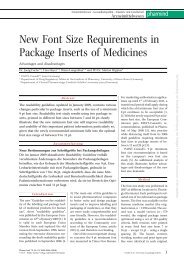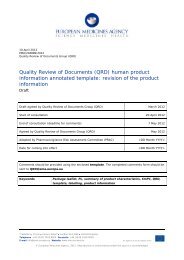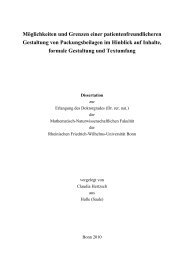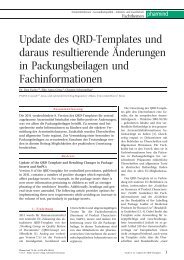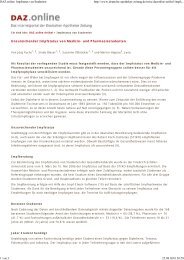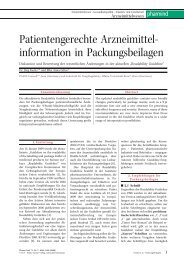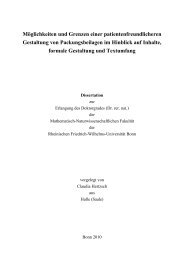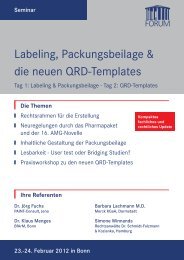draft statement - PAINT-Consult
draft statement - PAINT-Consult
draft statement - PAINT-Consult
Create successful ePaper yourself
Turn your PDF publications into a flip-book with our unique Google optimized e-Paper software.
<strong>PAINT</strong>-<strong>Consult</strong> Dr. Jörg Fuchs Magnus-Poser-Str. 6 07749 Jena<br />
Bundesinstitut für Arzneimittel und Medizinprodukte<br />
Kurt-Georg-Kiesinger Allee 3<br />
D-53175 Bonn<br />
<strong>PAINT</strong>-<strong>Consult</strong><br />
Dr. Jörg Fuchs<br />
Magnus-Poser-Str. 6<br />
07749 Jena, Germany<br />
Phone: +49 (0) 36 41 – 54 93 96<br />
Fax: +49 (0) 36 41 – 54 93 97<br />
E-Mail: info@paint-consult.com<br />
Internet: www.paint-consult.com<br />
Ihr Zeichen: Ihre Nachricht vom: Unser Zeichen: Datum<br />
JF 03.06.2006<br />
Draft Statement:<br />
2. Proclamation of the revised version regarding the recommendations for package<br />
insert design according to paragraph 11 of the German drug law for human<br />
pharmaceuticals.<br />
(state of discussion 07.04.2006)<br />
Via the Directive 2004/27/EC several changes regarding the package insert design were discharged,<br />
which concerned for example the new sequence of the arrangement and the accomplishment of<br />
readability tests. Above all the practical implementation of new requirements raised questions relating<br />
to the conversion consistency. Therefore, based on the experiences of <strong>PAINT</strong>-<strong>Consult</strong> as provider of<br />
readability tests in addition to package insert research for many years, a <strong>statement</strong> is delivered to the<br />
<strong>draft</strong> specified above in the following.<br />
1. Package insert readability tests<br />
Putting new recommendations in place for discussion, before implementation, is in principle positive<br />
as it facilitates the inclusion of useful suggestions from practical experiences. Thereby, the Federal<br />
Institute for Drugs and Medical Devices (BfArM) perception as contained in the <strong>draft</strong> is particularly<br />
interesting, as the frequently asked question relating to the readability test accomplishment, is<br />
addressed and/or answered here.<br />
It is important to have a clear regulation which states whether or not a readability test must be<br />
accomplished or can be void. Included also should be, the extent to which a readability test relating to<br />
one drug is generally sufficient for different application forms of pharmaceuticals, whether there are<br />
exceptions and if so which ones.
<strong>PAINT</strong>-<strong>Consult</strong><br />
According to Fuchs, the following issues must supplement the written readability test (2, 3):<br />
- The test procedure must contain a comprehensibility evaluation based on proved quality criteria.<br />
The proving must takes place prior to patient testing.<br />
- The tested group must cover a minimum 2 groups of 10 people, which is similar to the interview<br />
procedure of Sless and Wiseman (4).<br />
- In addition to questions relating to content, different participant <strong>statement</strong>s relating to the package<br />
insert usability must also be questioned.<br />
- The written readability test was evaluated via several studies (2, 5, 6).<br />
2. Improving package insert comprehensibility<br />
Active patient requesting<br />
The patient target group can be better achieved via active requesting. However, this kind of patient<br />
motivation must be used carefully, e.g. in headings or contents of particular importance only. When<br />
this medium is used too frequently, the reader will no longer notice it as the effect is minimised. For<br />
this reason and in an effort to minimise the extent of information, each point in chapter 2 („Do not take<br />
/ use X“ and „Take special care with“) according to the new annex relating to the wording of package<br />
inserts (7), should not start with or .<br />
Statements with preferably precise usage instructions<br />
The information contained in the package insert can only be appropriately used by patients via precise<br />
instructions. Non quantifiable phrasings like ‘high dosage” or “recently applied” should be avoided.<br />
They do not enable the patient to clearly rate the importance of the information brokered. Thus, some<br />
people will understand “recently used” as a time period of up to about 3 days, while others may<br />
comprehend it as being 1 month or more (2).<br />
Usually, non quantifiable phrasings can be conveyed more comprehensibly per <strong>statement</strong>s in<br />
numbers (2). However, for some issues there are too few results which convey precise information to<br />
patients. Chapter 2 „ other medicines“ contains the following sentence:<br />
„Please tell your doctor or pharmacist if you are taking or have recently taken any other medicines,<br />
including medicines obtained without a prescription.“<br />
In addition to being too extensive for a usage instruction, according to the Readability-Guideline of<br />
1998, this sentence is longer than the recommended maximum length of 20 words per sentence (6).<br />
Furthermore it contains the described non quantifiable <strong>statement</strong> “recently taken”. However, this<br />
<strong>statement</strong> is specified in the QRD-Template Version 7 (9), in which each company is supposed to use<br />
this ambiguous phrasing based on the Template.<br />
Suggestion for an improved and above all shorter phrasing:<br />
“Inform your doctor or pharmacist if you have used the following medicines within the last 14 days.” (2)<br />
2
<strong>PAINT</strong>-<strong>Consult</strong><br />
According to the half-life period of the medicines contained under this chapter, a shorter or longer time<br />
period of “14 days” might be necessary.<br />
The current QRD-Template must be optimized simultaneously, to ensure unitary writing within the<br />
European Union and avoid problems such as other European Union member state admission<br />
authorities disallowing German texts.<br />
A further example of the Template non quantifiable phrasings concerns the <strong>statement</strong>s relating to<br />
„older people“. Information relating to age range in years should be listed similarly to children, this can<br />
be interpreted differently by everyone.<br />
The heading „Take special care with X“ contains no precise usage instruction, the special<br />
precautionary actions to be accomplished are therefore not conveyed. A general reference to the<br />
doctor would surely be more significant: „Ask your doctor before you X“.<br />
Many package inserts do not contain clear usage instructions under the subheadings „Pregnancy and<br />
breast-feeding“ and „Driving and using machines“, especially if there is an unclear data situation. For<br />
this reason more precise <strong>statement</strong>s relating to these issues should be given such as:<br />
- Do not use .../ Do not drive or use any tools or machines as<br />
- You can use .../ You can drive or use any tools or machines after taking X.<br />
- Ask your doctor or pharmacist for advice as to whether you can take this medicine during<br />
pregnancy or breast-feeding. / Ask your doctor or pharmacist for advice as to whether you can<br />
drive or use any machines during X therapy.<br />
Renouncement of text repetitions<br />
Text repetitions should be avoided where possible (8, 10) and should also be considered in the<br />
Templates. This is particularly important, since patients as well as medical and pharmaceutical<br />
specialists require shorter and more concise package inserts which are limited to the most important<br />
information (figure) (5, 6).<br />
3
<strong>PAINT</strong>-<strong>Consult</strong><br />
The extent should...<br />
Frequency (%)<br />
100<br />
The content should...<br />
Frequency (%)<br />
100<br />
80<br />
80<br />
60<br />
60<br />
40<br />
40<br />
20<br />
20<br />
0<br />
0<br />
be larger persist be shorter be more<br />
detailed<br />
persist<br />
be limited to the<br />
most important<br />
patients n = 855 (5), specialists n = 219 (6)<br />
For example consulting a doctor or pharmacist as an action when side effects occur is recommended<br />
in the information box (below the name of the medicine) and twice within chapter 4. Given that this<br />
reference is of particular importance, it should be emphasized but listed only once. However, in<br />
addition to this, the National guidelines and QRD Templates must be optimized, particularly because<br />
the information box and chapter 4 states only "serious side effects". This non quantifiable phrasing<br />
does not ensure precise instruction usage.<br />
Furthermore this chapter states the instruction to inform the doctor or pharmacist only if a side effect<br />
not stated in the package insert occurs. Based on this information alone, according to the<br />
extrapolation of <strong>PAINT</strong>1-study data (2); 900,000 people in Germany would only consult their doctor if<br />
a side effect, not mentioned in the package insert, occurred. This issue also represents a risk in drug<br />
safety.<br />
Suggestion for shorter and more precise phrasing:<br />
“Inform your doctor or pharmacist with each occurring side effect, even if this is not contained in the<br />
package insert.”<br />
The Template contains a further repetition regarding the effective substance. This is specified under<br />
the name of the medicine and in chapter 6.<br />
4
<strong>PAINT</strong>-<strong>Consult</strong><br />
Expansion of content requirement for texts<br />
The <strong>statement</strong> at the end of the proclamation, not to further expand the texts content requirement, is in<br />
principle to be welcomed. To facilitate the acquisition of each possibility, further and often very large<br />
texts are needed.<br />
Here, all European and National template phrasing should be tested to evaluate whether or not they<br />
are necessary and/or if they can be more condensed. The extensive information box below the name<br />
of the medicine is to be taken as an example. In addition to the redundancy regarding the actions to<br />
take with side effects, already described above, the request to read the package insert is contained<br />
here. The text “Package leaflet - please read carefully”, in the past commonly used in Germany, was<br />
much shorter and originally better positioned i.e. before the name of the medicine in contrast to the<br />
current version. To convert the active request into a short phrase, it could be optimized as follows:<br />
Suggestion:<br />
“Please read the package insert carefully!”<br />
The information in the package insert which relates to the Marketing Authorisation Holder and<br />
Manufacturer is of less importance to patients or the medicinal and pharmaceutical specialists (5, 6).<br />
However centrally certified medicinal package inserts contain the Marketing Authorisation Holder’s<br />
local representative from each European Union member country. This QRD Template guideline does<br />
not conform at all with patient requirement for short and most importantly, concise package inserts,<br />
already described above.<br />
In addition to this, future package inserts containing the Marketing Authorisation Holder’s address<br />
only, should be discussed. Firstly, the additional Manufacturer’s address is of less importance to<br />
patients as well as medical and pharmaceutical specialists and secondly, it is not necessary for drug<br />
safety.<br />
The recent specification of the Marketing Authorisation Holder’s European selling countries and the<br />
medicinal trade names is only an unnecessary increase in the package insert volume. Each<br />
pharmacist is able to state the appropriate names of the medicine or alternatives, based on internal<br />
software. These references should not be used in package inserts anymore.<br />
Furthermore, although the 1998 Readability Guideline requires abbreviation avoidance (8), the<br />
abbreviation "EEA" is nevertheless used. In addition, this abbreviation is generally not well-known to<br />
patients. Examples of this ambiguous interpretation are as follows:<br />
• European Environment Agency; under: www.eea.europa.eu/<br />
• European Energy Award; under: http://www.eea.nrw.de/<br />
• European Economic Association; under:<br />
http://ec.europa.eu/comm/external_relations/eea/index.htm<br />
• Einheitliche Europäische Akte; under: http://de.wikipedia.org/wiki/EEA<br />
5
<strong>PAINT</strong>-<strong>Consult</strong><br />
Abbreviations<br />
In addition to the abbreviation „EEA“ already addressed in chapter 6, other abbreviations relating to<br />
the composition of the medicine are also used in this chapter, such as the inactive substances E-<br />
numbers and their dispensatory related specifications such as, "Ph. Eur.".<br />
Both are generally not comprehensible for patients. Substances with E-numbers are frequently<br />
classified by consumers as dangerous, even if they concern harmless substances such as<br />
saccharose.<br />
Dosage instruction<br />
The use of a table for the dosage instruction is reasonable. According to the <strong>PAINT</strong>1-study the clarity<br />
and comprehensibility of information can be increased in the process (2). In individual cases a well<br />
emphasized dosage instruction might also be easily understood without a table.<br />
However, the body weight should generally not be noted in addition to the children age data. Since<br />
children do not always have their age appropriate weight (11, 12), a data differ related to the age<br />
and/of weight might occur.<br />
A Paint-<strong>Consult</strong> study not yet published, was accomplished in May 2006 with 207 participants. The<br />
results found that dosage data concerning age and the body weight is of no assistance to patients in<br />
decision making. According to the results it is difficult for patients to seize the correct dosage via this<br />
form of dosage instruction.<br />
Therefore, for comprehensibility purposes only one criterion of choice should be recommended, either<br />
age or body weight. The data referring to the age should be preferred, as long as it does not concern<br />
a medicine with a small therapeutic index, such as cytostatic drugs.<br />
Regarding the dosage instruction, the dosage stated in number of tablets or capsules and/or the<br />
volume of ready to use medicine should definitely be included in the QRD-Template. Unfortunately<br />
many package inserts contain dosage instructions in form of quantity specifications of the effective<br />
substance (13). According to the <strong>PAINT</strong>1-study such dosage references are very frequently<br />
misunderstood (2) (see abstract appendix 1).<br />
Field of application<br />
In relation to the chapter heading „What X is and what it is used for” the action mechanism should<br />
firstly be specified and only thereafter the actual indications should be listed. On account of this<br />
according to the <strong>PAINT</strong>1-study and previously accomplished readability tests, patients understand<br />
parts of the action mechanism as fields of application. For this reason a chapter heading sequence<br />
change is suggested, to allow the more important information relating to the fields of application to be<br />
specified firstly.<br />
6
<strong>PAINT</strong>-<strong>Consult</strong><br />
In addition to this, the heading should be written in more appropriate English, such as „What X is used<br />
for and what it is “. Several participants who had already accomplished a readability test, criticized the<br />
existing version of the heading.<br />
Dr. Jörg Fuchs<br />
<strong>PAINT</strong>-<strong>Consult</strong>, managing director<br />
7
<strong>PAINT</strong>-<strong>Consult</strong><br />
References<br />
1 Bekanntmachung der Neufassung des Arzneimittelgesetzes vom 12. Dezember 2005, BGBl.<br />
Teil I, Nr. 73.<br />
2 Fuchs, J.: Die Packungsbeilagen als ein Mittel zur gezielten Information und Handlungsanleitung<br />
für Patienten - Entwicklung und Testung eines Instrumentes zur Beurteilung und Optimierung der<br />
Packungsbeilagen von Arzneimitteln [Dissertation] [Package inserts as medium to convey<br />
targeted information and directions for use to patients: Developing and testing a tool to rate and<br />
optimize pharmaceutical product package inserts]. Humboldt University Berlin, (2005). (abstract<br />
appendix 1).<br />
3 <strong>PAINT</strong>-<strong>Consult</strong> - Fuchs, J: instruction to carry out the written readability test, 2005.<br />
4 Sless, D.; Wiseman, R.: Writing about medicines for people: usability guidelines for consumer<br />
medicine information. Department of Health and Family Services, Canberra (1997).<br />
5 Fuchs, J., Hippius, M., Schaefer, M.: A survey of package inserts use by patients. Hospital<br />
Pharmacy Europe 2005; 21: 29-31 (appendix 2).<br />
6 Fuchs, J., Questioning specialists on the importance of different information as contained on<br />
package inserts and the desired sequence of the structure, unpublished survey.<br />
7 BfArM: Anlage: Wortlaut der für die Packungsbeilage vorgesehenen Angaben, Stand:<br />
19.12.2005. unter<br />
http://www.bfarm.de/cln_043/nn_424304/SharedDocs/Publikationen/DE/Arzneimittel/Gebrauchsi<br />
nformationNichtVerschreibungspflichtig,templateId=raw,property=publicationFile.rtf/Gebrauchsinf<br />
ormationNichtVerschreibungspflichtig.rtf am 26. April 2006.<br />
8 European Commission: A guideline on the readability of the label and package leaflet of<br />
medicinal products for human use, Brussels, 29. September 1998. (1998).<br />
9 EMEA: QRD Human Product Information Templates - Medicinal Products for Human Use,<br />
Version 7, July 2005. http://www.emea.eu.int/htms/human/qrd/qrdplt/AnnotatedTemplate-h.pdf,<br />
10th February 2006.<br />
10 BfArM: Bekanntmachung über die Neufassung der Empfehlungen zur Gestaltung von<br />
Packungsbeilagen nach § 11 des Arzneimittelgesetzes (AMG) für Humanarzneimittel vom 15.<br />
März 2002. BAnz. 78 (2002) 9083.<br />
11 Breitkreutz, J.; Kleinebudde, P.; Boos, J.: Kindgerechte Arzneiformen - Arzneimitteltherapie für<br />
alle. Pharmazeutische Zeitung 147 (2002) 3210-3218.<br />
12 EMEA: ICH Topic E 11 - Clinical investigation of medicinal products in the paediatric population -<br />
Note for guidance on clinical investigation of medicinal products in the paediatric population<br />
(CPMP/ICH/2711/99). (2000).<br />
13 Fuchs, J.; Hippius, M.; Schaefer, M.: Analysis of German package inserts. Int J Clin Pharmacol<br />
Ther 44 (2006) 8-13 (appendix 3).<br />
8
<strong>PAINT</strong>-<strong>Consult</strong><br />
Appendix 1:<br />
<strong>PAINT</strong>1-study, a Cross-Over-Comprehensibility-Test of 5 original and 5 model<br />
package inserts [abstract] (2)<br />
[Fuchs, J.; Hippius, M.; Schaefer, M.: Package inserts and their comprehensibility for<br />
patients. Proceedings Workshop Programme and Abstracts - 13th international social<br />
pharmacy workshop (2004) 42.]<br />
9
Package inserts<br />
and their<br />
comprehensibility for patients<br />
Jörg Fuchs a , Marion Hippius b , Marion Schaefer a<br />
• Institute of Pharmacy at Humboldt University Berlin a<br />
• Institute of Clinical Pharmacology, Friedrich Schiller University Jena b<br />
• e-mail: jfuchs-jena@t-online.de<br />
Background:<br />
• Package inserts are very important for patient information<br />
• Their suitability is still under discussion.<br />
• Recommendations for testing the readability are given by the European Commission. ²<br />
• According to Sless and Wiseman: 1<br />
1. Over 90 % of the patients find the relevant information.<br />
2. Over 90 % of those finding the information are able to understand it.<br />
3. Thus over 81 % of the patients in total are able to use the package inserts<br />
appropriately.<br />
Aims:<br />
• The <strong>PAINT</strong> survey (package insert test) examined the comprehensibility and<br />
availability of information from five package inserts * for different drugs and five<br />
model package inserts ** for the same drugs developed for this test.<br />
Methods:<br />
• A questionnaire with 15 questions referring to the content of the package inserts was<br />
adapted using references by Sless and Wiseman 1 ,<br />
the EMEA ² and the EFPIA ³ for a written survey.<br />
• 1,150 patients were asked to participate in the <strong>PAINT</strong> survey.<br />
• Cross over testing<br />
• Every person got an original * and one model ** package<br />
insert within an interval of 4 weeks.<br />
• Time: September 2002 to April 2003<br />
Results:<br />
model **<br />
• 1,105 persons answered the questionnaire in the first trial and<br />
1,051 in the second trial (return rate: 95.9 and 91.2 %).<br />
• Participants:<br />
- 10 to 92 years old, average age: 38 years<br />
original *<br />
- 69.1 % living in or near Jena, 30.9% in other parts of Germany<br />
- 65.4 % woman, 34.6 % man<br />
• Questions to the content of package inserts (Table 1)<br />
- original versions: 74.7 to 85.8 % of all questions were answered correctly<br />
3.8 to 6.9 % answers not found<br />
- model versions: 92.6 to 94.4 % of all questions were answered correctly<br />
2.2 to 2.5 % answers not found<br />
• Time needed to answer the 15 questions (Table 2)<br />
- original versions: 14.3 to 19.6 minutes<br />
- model versions: 10.9 to 13.8 minutes<br />
• The question: „What is the maximum dose for a day?“ (Table 3)<br />
- original versions: 9.4 to 90.2 % answered correctly<br />
0.9 to 9.9 % answers not found<br />
- model versions: 83.6 to 94.0 % answered correctly<br />
0 to 0.5 % answers not found<br />
Frequently mistakes regarding the original package inserts were connected with<br />
dosage instructions in milligram instead of „tablet“ or volume. The maximal daily dosage<br />
was better found in those versions presenting this information in a table.<br />
Conclusions:<br />
• It is possible to improve package inserts.<br />
• All models but only 2 original package inserts are easy to understand.<br />
• With regard to dosage instructions the following is recommended:<br />
1. Every dose should be given in a number of tablets or capsules and<br />
volume respectively.<br />
2. Dosage instructions should be given in a table.<br />
1 Sless, D.; Wiseman, R.: Writing about medicines for people: usability guidelines for consumer<br />
medicine information. Department of Health and Family Services, Canberra (1997)<br />
² European Commission: A guideline on the readability of the label and package leaflet<br />
of medicinal products for human use, Brussels, 29. September 1998. (1998)<br />
³ EFPIA: EFPIA general recommendations for readability user testing of package leaflets<br />
for medicinal products for human use submitted or approved under<br />
the European centralised procedure - final document - Version from March 2003.<br />
Table 1: Correctness of answers concerning the content of<br />
original vs model package inserts (15 questions)<br />
package<br />
insert<br />
correct<br />
answers (%)<br />
answers not<br />
found (%)<br />
n<br />
(calculated median) (calculated median)<br />
original model original model original model<br />
Enalapril 78.5* 93.2 6.7* 2.5 218 214<br />
Ibuprofen 85.8* 94.4 6.9* 2.3 215 213<br />
Paracetamol 82.6* 93.3 3.8* 2.2 213 219<br />
Repaglinide 79.0* 93.3 4.5* 2.3 214 216<br />
Telmisartan 74.7* 92.6 6.2* 2.3 213 216<br />
( * significant differences between the results of the original and<br />
the model version of package inserts)<br />
Table 2: Calculated median of the time needed to answer<br />
the 15 questions<br />
package<br />
insert<br />
time to answer the<br />
15 questions (min)<br />
n<br />
original model original model<br />
Enalapril 19.6* 13.1 203 197<br />
Ibuprofen 18.8* 12.4 200 200<br />
Paracetamol 14.3* 12.0 197 203<br />
Repaglinide 15.3* 13.8 204 199<br />
Telmisartan 15.3* 10.9 195 198<br />
( * significant differences between the results of the original and<br />
the model version of package inserts)<br />
Table 3: Calculated median for the answers to the question:<br />
“What is the maximum dose for one day?”<br />
package<br />
insert<br />
correct<br />
answers (%)<br />
answers not<br />
found (%)<br />
n<br />
original model original model original model<br />
Enalapril 52.5* 83.6 0.9 0 217 213<br />
Ibuprofen 90.2 90.0 1.4 0 215 210<br />
Paracetamol 9.4* 84.9 7.0* 0 213 218<br />
Repaglinide 36.0* 94.0 7.5* 0.5 214 216<br />
Telmisartan 33.3* 92.1 9.9* 0.5 213 216<br />
( * significant differences between the results of the original and<br />
the model version of package inserts)
<strong>PAINT</strong>-<strong>Consult</strong><br />
Appendix 2:<br />
Questioning patients on the importance of different information as contained on<br />
package inserts and the desired sequence of the structure (n = 855 participants) (5)<br />
10
<strong>PAINT</strong>-<strong>Consult</strong><br />
Appendix 3: Analysis of 68 package inserts already available on the pharmaceutical market (4)<br />
11



